“If you know somethin’ well, you can always paint it, but people would be better off buyin’ chickens.”
—Grandma Moses
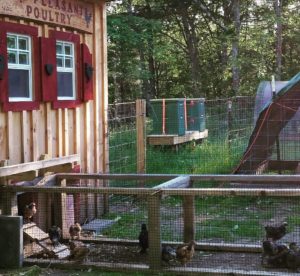
Handmade chick run attached to the chicken coop
Grandma Moses was right with the second part of that quote. People would be better off buyin’ chickens.
So, say you listened to Grandma Moses, and you have your chickens. Congratulations. Enjoy them every day. They provide so much more than eggs. Then, what if you enjoy them so much, and somewhere down the road, you need more? Or you don’t really need them, but want them?
Whether you are introducing new birds based on need or want, you need a game plan to ensure it goes as smooth as possible. If you are interested in the health and safety of everyone involved, be prepared to take the time to do it properly. Have patience. Do not rush the process.
Whether the new birds are ones that were born on your property or obtained elsewhere, they need to be old enough to somewhat protect themselves or have the sense to hide. A chick has no idea what’s what. Large age differences between the old and new birds put the younger ones at a disadvantage. It needs to be shown places to eat, hide, and sleep. It would be nice, but a hen who previously had chicks will not always take unknown babies under her wing.
What is the best age to introduce chicks to older birds? I believe in safely introducing no sooner than eight weeks- which is an acceptable quarantine time
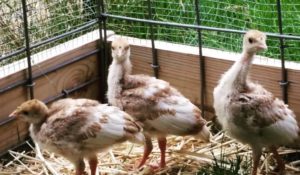
Turkey poults just feathering out. Warm days spent in chicken tractor next to adult bird yard
Here are the pros and cons of the various chicken introduction techniques:
Tossing newcomers in with their current flock technique.
Pro: You don’t do anything. Just toss them in. Normal bird behavior will include establishing flock hierarchy. Pecking is the most common method to achieve this. Some members of a flock may keep their distance to newcomers, some may give warning pecks, while others will attack. Even the sweetest of birds can become violent if they feel threatened by a newcomer.
Cons: This method can add stress to all the animals, possibly spreads viruses or diseases, trigger fighting (beyond the normal pecking order), and generally can be a very scary thing for the birds. Be aware, that if a bird gets severely injured, it will need to be doctored and moved to a safer environment (on your property or elsewhere) or culled.
If a bird is too injured to eat and drink or is unable to receive sustenance (food, water, and shelter) due to excess flock bullying, it is your responsibility. Failure to provide livestock with care consistent with customary animal husbandry practices is considered neglect in most states.
The “adding new birds to the coop at night” technique
Pros:
Sleepy birds are calmer birds. The existing flock may be too tired to confront newcomers at night, but in the morning, it can lead to a con.
Cons:
I’ve heard people say that this works, but I have yet to meet anyone who actually had success with this.
Come daylight, the existing flock may not appreciate the newcomers’ presence in their home. Chickens are not stupid. They know their flock mates by sight. Imagine waking up to a stranger in your home.
The newcomers have zero clues to where they are. They were just stuck in a dark coop. They are in a strange place with strange birds and have no idea where to hide if violence erupts.
Even if you can guarantee to get to the coop before dawn, no one can ever convince me that this is a good method, especially when there are less stressful methods to use.
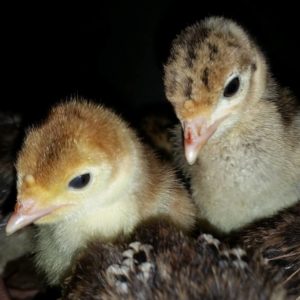
Babies hiding in a safety box
Adding another coop/Creating another flock
Pros:
Each flock has its own home base. You can get birds of any age, breed, or size, and not worry about integration. If they will share a yard or the property, that will still need to be monitored at first, but an additional coop can eliminate some of the fighting/pecking order issues. You will still need to quarantine new birds if you want to minimize disease issues but adding a second coop is a good option for many.
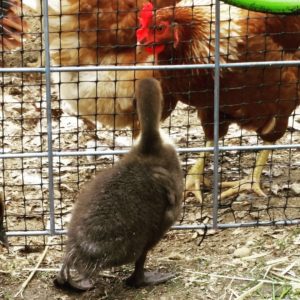
A duckling safely getting to know his new neighbor
Slow introduction
The middle of the road technique, between simply tossing newcomers in the coop and setting up an additional coop is the slow introduction.
It is desirable to have more than one bird to introduce. A buddy (or buddies) to navigate their new home.
New birds eat and sleep in their own temporary coop in the main chicken yard, within a divided off section. or they live in a portable tractor, which gets moved next to the main chicken area. Either way, various flocks can get used to each other, without harm. With a barrier between them. They can live next to each other and observe each other through the mesh or chicken wire.
During the introduction period, I let the flocks out in shifts. The newcomers can explore the property when the other birds are in their personal poultry yards. This gives you an opportunity to educate the new birds as to the layout of the property, farm boundaries, safe hiding places, and the rules. It is much easier to teach them the rules without the existing flocks interfering.

Goats and ducks coexisting
As time passes, the flocks are let out together. With supervision. As in, do not leave your property to run an errand or go to work. Give them space but be nearby in case you are needed. Let them be chickens. They may puff up, peck, chase each other, etc.… but outright gang behavior or violent attacks need to be stopped immediately. You know it’s going well if they keep one eye on each other but stay busy just pecking around.
Avoid throwing excessive treats during introduction time. Food can trigger chaos. Save the treats for when they get back in their own yards. Although, sprinkling the ground with seeds before letting everyone out can give them something to do.
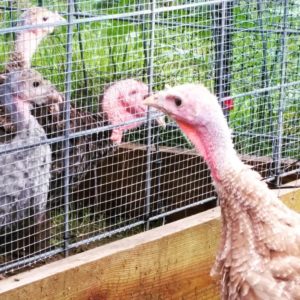
One group in a tractor, while another group free ranges
In the case of chicks or ducklings, hiding spaces are much appreciated. We made sturdy wooden boxes with openings too small for adult birds to fit through. I place them around the property, and in the coops.

Homemade safety/hiding boxes for babies
You will see when the flocks appear to accept each other. Then you can move the newcomers into the main coop. At that point, they will be more confident. Continue to monitor the situation. Any excessive bullying or fighting should never be tolerated.
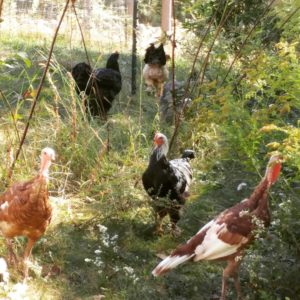
Turkeys and chickens coexisting after a slow introduction
Whatever method you choose, please make the safety of all your animals your most important priority. There will be plenty of time to relax and enjoy your new birds, once they are integrated. Your first step is to do it safely.

Ducklings safe space in the adult duck house
So, back to Grandma Moses (September 7, 1860 – December 13, 1961).
Anna Mary Robertson was born into a farming family. She grew up on a farm. Her father ran a flax mill. At the age of 12, she became a housekeeper, her first paying job, on farms. She married a farmer, Thomas Moses. They lived and worked on four different farms over two decades, eventually buying their own. She was an embroiderer, wife, mother, and farmer. She started painting in her mid-seventies. She painted “old-timey” New England scenes. She lived to 101 years of age. I think it’s because she spent so much time with chickens. I bet she did lots of chicken introducing.
In her own words: “If I hadn’t started painting, I would have raised chickens.”












